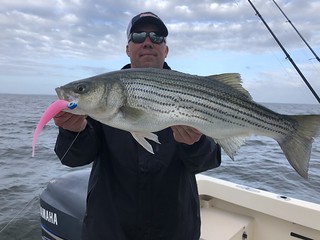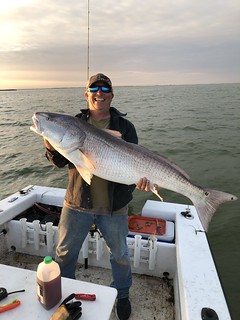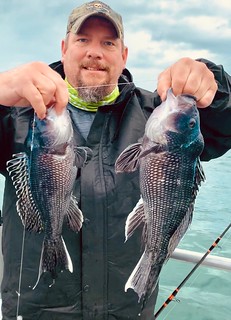Maryland Fishing Report – May 27

Christian Gruber managed to spend some time fishing for largemouth bass in a local pond — and came up big with this 23-inch largemouth bass that he released after a quick picture. Photo courtesy of Kirk Groves
Maryland is beginning to settle into something resembling summer, and anglers are out safely enjoying the outdoors.
As we continue doing our part to keep transmission of COVID-19 to a minimum, please remember to check our website to find the latest guidance on a variety of outdoor activities.
Our Forecast Summary will return next week.
For more detailed and up-to-date fishing conditions in your area of the bay, be sure to check out Click Before You Cast. Get regular updates on Maryland’s waters sent to your inbox with our Eyes on the Bay newsletter. Sign up online.
Anglers in the lower Susquehanna River are seeing clearer water conditions; the Conowingo Dam is on a power generation schedule. Most anglers are fishing in the dam pool for flathead catfish and for a mix of blue and channel catfish in the lower sections of the Susquehanna River. White perch are becoming more common and a welcome addition to the fishing scene.
The section of the river above the Lapidum-Twin Rocks-Tomes Wharf boundary line is still closed to striped bass fishing until June 1. Below that line south to the Turkey Point-Swan Point line is open to striped bass fishing with a 19-inch to 26-inch slot. The area from there south to a line from Abby Point to Worton Point is closed to striped bass fishing, while south of that line striped bass fishing is open with a 19-inch minimum length. The latest striped bass regulations can be found on the DNR website. Also, check the department’s website for a current striped bass map outlining areas open to fishing.
Those fishing for striped bass in the lower Susquehanna are jigging with soft plastics along channel edges or casting crankbaits and topwater lures in the early morning and late evening hours. Chunking or chumming seems to only attract catfish, which is not such a bad thing.
Farther down the bay, trolling along channel edges has been popular this week. Most are focusing their efforts on the eastern side where the water is clearer. Trolling spreads are often a mix of large parachutes and bucktails dressed with sassy shads in tandem, and umbrella rigs with medium-sized trailers or larger offerings. White tends to be a productive color.
Love Point Rocks has been an excellent place to jig with soft plastics this week, Podickory Point has been attracting those chumming or chunking. A mix of channel and blue catfish are dominating chum slicks in the upper bay. There has been good jigging action for striped bass at the Bay Bridge piers for those working soft plastics tight to the piers.

Travis Long holds up this beautiful striped bass for a photo before releasing it. Photo courtesy of Travis Long
Trolling along the shipping channel edges continues to be the most popular way to fish for the large trophy-sized striped bass. Most boats are trolling a mixed spread of large parachutes and bucktails dressed with large sassy shads in white and chartreuse. Umbrella rigs are also a common part of each trolling spread with storm shads or bucktails as trailers, often to entice the medium-sized striped bass.
The west side of the shipping channel from Thomas Point south to Chesapeake Beach, Breezy Point and Parkers Creek is a popular area to troll. The water clarity has been better on the east side of the bay and trolling near Bloody Point south to Buoy 83 down to the CP Buoy near the mouth of the Choptank has been popular. White has been edging out chartreuse as the most productive color for parachutes and bucktails dressed with sassy shads of matching colors. Water temperatures in the middle bay region are about 66 degrees and the salinity values are low.
There are other ways to fish for striped bass and those who love their light-tackle jigging are finding action near Poplar Island, the mouth of the Choptank River, and the shipping channel edges.
The outside edge of Hacketts Bar and Thomas Point have been two of the most popular places to try chumming, which has been yielding a few striped bass and catfish. Cownose rays are moving into the region and they are also attracted to chum slicks, which can frustrate those who think they may have a trophy sized striped bass on their line.
May worms are spawning on this month’s full moon and can be seen swarming at night under dock lights. They offer a feast for striped bass and white perch. This is a great time for both species to build up fat stores, but can make fishing difficult since fish need to be hungry to take your lure or bait. White perch have moved into their summer locations in the region’s tidal rivers and creeks and provide fishing opportunities off of docks and shoreline structure.

Michael Michelsen quickly holds up a 50-inch red drum he caught and released in Tangier Sound. Photo courtesy of Michael Michelsen
Although trophy striped bass may be on the minds of many anglers, there is a wealth of diverse fishing opportunities opening up this week. The first croaker, spot, speckled trout, and bluefish are making a presence and there was even a report of a Spanish mackerel caught in the lower bay. Large red drum are being caught as well as flounder.
Those looking for a trophy striped bass are trolling along the steep shipping channel edges in front of Cove Point, Point Lookout, and the steep channel edge near St. George’s Island in the lower Potomac River. Large parachutes and bucktails dressed with equally large sassy shads pulled in tandem behind planer boards or as a flat line are effective; white has been a favored color. Umbrella rigs are usually part of every spread and are often fished deeper with heavy inline weights. Some are placing large spoons into their trolling spreads for the large red drum in the area.
Jigging with soft plastics for striped bass has been good along channel edges and structure.. Most of the striped bass caught by jigging are between 19 inches and 26 inches. A few boats are chumming and are attracting medium-sized striped bass along with catfish, although this also attracts cownose rays.
Fishing for white perch has been very good in the tidal rivers and creeks. Most are casting small spinnerbaits and beetle spins near shoreline structure. Using bottom rigs baited with grass shrimp or pieces of bloodworm near docks and piers or deeper areas is also a good option. Croakers, spot, and speckled trout can now be part of the mix when fishing with bait. The mouth of the Patuxent River and the lower Potomac River near Piney Point are two places showing the best catches of croaker.
Speckled trout have moved into the region and although some can be caught near Point Lookout, the area of Pocomoke and Tangier sounds is producing the most action. Casting swimshads and similar soft plastics with light jig heads or small jerkbaits in the shallow areas has been working well for speckled trout. Drifting peeler crab baits at the mouths of small tidal creeks draining from the marshes has also been an excellent way to catch speckled trout.
Large red drum are being caught by drifting peeler crab baits at creek mouths and some are within the 18-inch to 27-inch legal slot size. Flounder continue to be found along channel edges and drop-offs near shallow flats in the Pocomoke and Tangier sounds. White or pink Gulp baits or squid have been working well.
Recreational crabbing is slowly gaining speed, there is currently the first shed of the season occurring. The best crabbing is being seen in the lower Eastern Shore this week. The 2020 Blue Crab Winter Dredge Survey results were recently released and are available online.

Charlie Pjura was fishing at Loch Raven Reservoir when he caught and released this fine looking largemouth bass. Photo by Charlie Pjura
Anglers are enjoying some very good fishing for smallmouth and largemouth bass in Deep Creek Lake. The bass are now holding under floating docks and catwalks, often in relatively shallow water. Tubes and soft plastic jigs are working very well in these situations. Walleyes are beginning to move into deeper waters now, but in the early morning and late evening they are being found in the shallower waters along the shorelines. Crankbaits and a shiner on a jig head combo have been working very well for this type of fishing. Bluegills are holding around floating docks and the deeper coves. Trout appear to be spread out throughout the lake.
Many of the streams and rivers are running a bit brisk this week from runoff but are showing signs of calming down. However, with more rain in the forecast, anglers should be careful. Most of the smallmouth bass in the upper Potomac have finished spawning and are moving to summer habitat. Small crankbaits, jerkbaits, and topwater lures have been effective on the smallmouth. Most of the fish have been along rocky shorelines and newly emerging water willow beds. Twitching a small jerkbait in eddy areas behind cover can be an effective tactic.
Trout fishing in the catch-and-release and fly-fishing-only areas is a delight this time of the year. In many of the trout streams and rivers, sulphurs are emerging in the afternoons and caddis are hatching late in the day into the evenings. Sulphurs and tan caddis are good choices to have in your fly box. The put-and-take areas are still holding trout, and casting small spinners and spoons with light spinning tackle is a good way to cover a lot of water to find trout that are spread out.
The reservoirs — Prettyboy, Rocky Gorge, Triadelphia, Piney Run, Loch Raven, and Liberty — have been providing some excellent largemouth bass fishing now that the fish are in their post-spawn activity phase and are holding to submerged wood and grass beds.
Largemouth bass are focusing on grass in search of food and cover. A good tactic is casting buzzbaits early in the morning near or over grass. Working plastic worms, stick worms, and jigs in the grass is a good way to get to bass holding underneath. In shallow waters and feeder creeks, small lipless crankbaits can be a good choice, as well as spinnerbaits.
Northern snakeheads can now be found in most every tidal river and creek in the Chesapeake watershed. They are in their spawning mode and are holding in shallow grass. Buzzbaits and frogs are a good way to entice them to strike. The tidal waters of the lower Eastern Shore and the creeks that feed into the Potomac River hold the greatest concentrations of northern snakeheads.
Crappie are holding near most any kind of structure. Fallen treetops and sunken wood are good places to look for them. In tidal waters, marina docks and bridge piers offer good structure to attract them. Bluegill sunfish offer plenty of fun fishing whether you are casting small rubber-legged poppers or ants with a fly rod or setting up the kids with a bobber and a worm.
Blue catfish offer plenty of action in many of the tidal areas of the Chesapeake. The lower Susquehanna River, the Potomac, Patuxent, Nanticoke, and Choptank rivers all hold expanding populations. Fresh cut bait of gizzard shad, sunfish or white perch all make good baits. Most of the tidal rivers hold populations of carp and they can offer fun fishing for bank fishermen. Corn makes one of the simplest baits but a little research will reveal there are all kinds of fruity smelling baits that can be used. Chumming an area you wish to fish the night before with corn can pay large dividends the next day.
The ocean waters have calmed down and surfcasters have been enjoying some relaxing time soaking baits. Medium-sized black drum are being caught on sand fleas or peeler crabs. Those soaking cut menhaden baits or finger mullet have been catching a few bluefish. Large striped bass should be venturing into the surf zone on their northerly migration; large cut menhaden baits are one of the best ways to entice them to pick up a bait. Cownose rays will begin to show up also soon if not already.
The inlet and back bay waters have cleared up and flounder fishing has been excellent. The channels leading towards the inlet have been popular places to fish as well as Sinepuxent Bay near the airport. Gulp baits in pink or white have been a good choice for bait and the minnow-squid combination will always be a favorite.
There has been some striped bass action around the inlet and the Route 90 Bridge. Casting swimshads and soft plastic jigs is a favorite way to fish for them. Most fail to reach the 28-inch minimum length but offer some fun catch-and-release action.
After almost a week of fierce winds, the ocean laid down a bit to allow charter and party boats to head out of the inlet and venture out to the offshore wreck and reef sites. Boat limits are common and some beautiful sea bass are being caught.
Some of the charter fleet from Ocean city took the long ride south to the Norfolk Canyon where they found yellowfin tuna. Perhaps some of those yellowfin will reach the canyon areas closer to Ocean City by the weekend.
“There is only one theory about angling in which I have perfect confidence and that is that the two words, least appropriate to any statement, about it, are the words ‘always’ and ‘never’” — Lord Grey of Fallodon, 1899
Maryland Fishing Report is written and compiled by Keith Lockwood, Maryland Department of Natural Resources fisheries biologist.
Click Before You Cast is written by Tidewater Ecosystem Assessment Director Tom Parham.
This report is now available on your Amazon Echo device — just ask Alexa to “open Maryland Fishing Report.”


